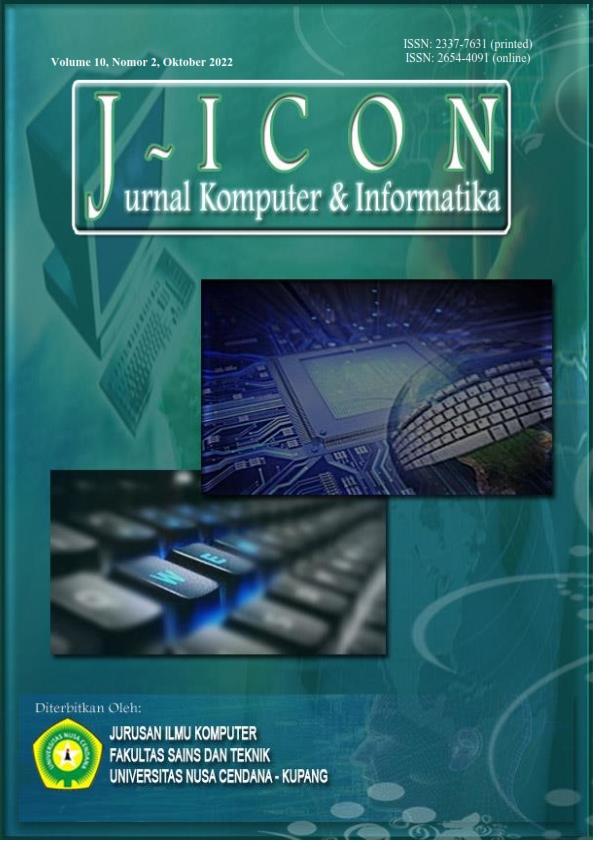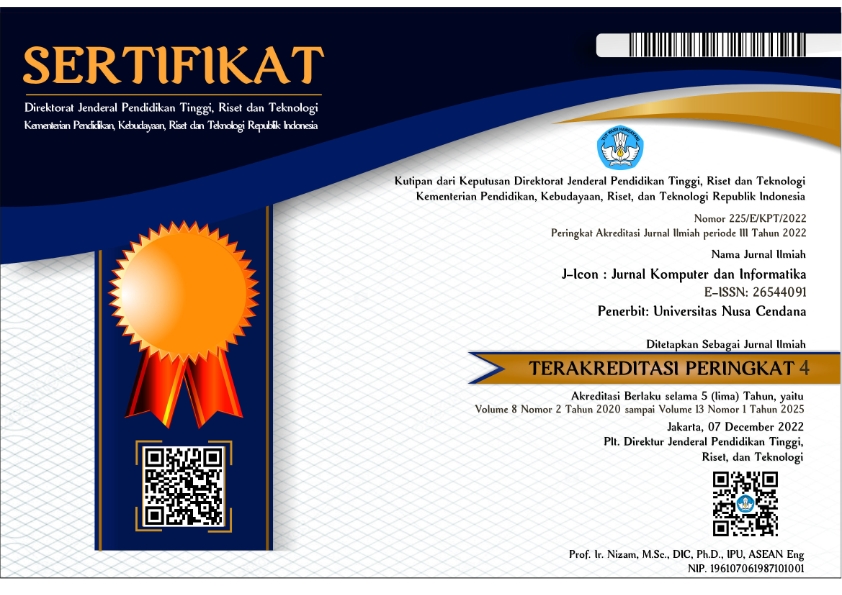EXPERT SYSTEM FOR DIAGNOSIS OF STUDENTS ANXIETY LEVEL IN THE UNDERGRADUATE THESIS PREPARATION USING CERTAINTY FACTOR METHOD
Abstract
The level of student anxiety when compiling a thesis impacts the length of the lecture process. The number of clinical psychologists not proportional to the number of students in East Nusa Tenggara causes many students not to consult a psychologist. An expert system for diagnosing student anxiety levels using the certainty factor method with a HARS scale for 14 criteria and 81 symptoms will help students analyze their anxiety levels. The results of the study based on 300 student data obtained that the accuracy of the expert and system results was 100%, where the more extended the study period, the higher the level of anxiety in students.
Downloads
References
R. Nelson-Jones, Theory and practice of counselling and therapy. Sage, 2010.
N. K. A. Suarti, F. H. Astuti, I. M. Gunawan, H. Ahmad, and A. Abdurrahman, “Layanan Informasi Dalam Rangka Meminimalisir Kecemasan Akademik Siswa,” J. Pengabdi. UNDIKMA, vol. 1, no. 2, pp. 111–117, 2020.
E. V. B. Dede, S. A. S. Mola, and Y. Y. Nabuasa, “Implementasi Hamilton Anxiety Rating Scale untuk Mendiagnosis Tingkat Kecemasan pada Mmahasiswa Dalam Penyusunan Skripsi,” J. Komput. Dan Inform., vol. 10, no. 1, pp. 55–64, 2022.
I. P. K. Indonesia, “Statistik Keanggotaan Ikatan Psikolog Klinis Indonesia,” Diakses Dari Simak Ipkindonesia Id, 2020.
“Jumlah mahasiswa di indonesia pddikti - Penelusuran Google.” https://www.google.com/search?q=jumlah+mahasiswa+di+indonesia+pddikti&oq=jumlah+&aqs=chrome.0.69i59l2j69i57j0i433i512j0i512l6.3392j0j15&sourceid=chrome&ie=UTF-8 (accessed Mar. 28, 2022).
K. A. Kaswadi, A. Malik, and O. B. Keat, “Anxiety and academic achievement among undergraduate students,” J Manag Sci, vol. 16, pp. 11–18, 2018.
B. R. Sæmundsson, F. Þórsdóttir, H. Kristjánsdóttir, D. Þ. Ólason, J. Smári, and J. F. Sigurðsson, “Psychometric properties of the Icelandic version of the Beck Anxiety Inventory in a clinical and a student population.,” Eur. J. Psychol. Assess., vol. 27, no. 2, p. 133, 2011.
R. Manap, M. A. GHANI, and S. A. HAMID, “Mental Health Problems among Undergraduate Students in Private Educational Institution,” J. Soc. Humanit., vol. 16, no. 2, p. 7, 2019.
H. F. Dalky and A. Gharaibeh, “Depression, anxiety, and stress among college students in Jordan and their need for mental health services,” in Nursing forum, 2019, vol. 54, no. 2, pp. 205–212.
L. Angelin, S. V. Wetik, and P. A. Ferlan, “Tingkat Stres Berhubungan dengan Kejadian Generalized Anxiety Disorder (GAD) pada Mahasiswa Tingkat Akhir,” J. Keperawatan Jiwa JKJ Persat. Perawat Nas. Indones., vol. 9, no. 2, pp. 399–408, 2021.
J. Lee, H. J. Jeong, and S. Kim, “Stress, anxiety, and depression among undergraduate students during the COVID-19 pandemic and their use of mental health services,” Innov. High. Educ., vol. 46, no. 5, pp. 519–538, 2021.
M. N. Hoque, A. Hannan, S. Imran, M. A. Alam, B. Matubber, and S. M. Saha, “Anxiety and its determinants among undergraduate students during E-learning in Bangladesh amid covid-19,” J. Affect. Disord. Rep., vol. 6, p. 100241, 2021.
P. Talwar, S. Matheiken, J. L. A. Cheng, and S. Sabil, “Reliability and Factor Structure of the Westside Test Anxiety Scale among University Students,” Online J Health Allied Scs, vol. 18, no. 3, p. 8, 2019.
D. Heckerman, “The certainty-factor model,” Encycl. Artif. Intell., pp. 131–138, 1992.
J. C. Giarratano and G. D. Riley, Expert systems: principles and programming. Brooks/Cole Publishing Co., 2005.
Copyright (c) 2022 Maria Louise L. Muku, Sebastianus A. S. Mola, Meiton Boru, Nelci D. Rumlaklak, Tiwuk Widyastuti

This work is licensed under a Creative Commons Attribution 4.0 International License.
The author submitting the manuscript must understand and agree that if accepted for publication, authors retain copyright and grant the journal right of first publication with the work simultaneously licensed under a Creative Commons Attribution (CC-BY) 4.0 License that allows others to share the work with an acknowledgment of the work’s authorship and initial publication in this journal.
 Maria Louise Ludgardis Muku(1*)
Maria Louise Ludgardis Muku(1*)




